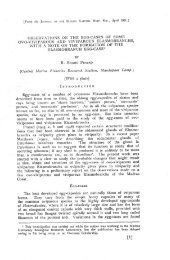PDF - Eprints@CMFRI
PDF - Eprints@CMFRI
PDF - Eprints@CMFRI
You also want an ePaper? Increase the reach of your titles
YUMPU automatically turns print PDFs into web optimized ePapers that Google loves.
173<br />
Three specimens of this species are available, collected by Prof. FR ICKE with his submersible "Geo"<br />
at a depth of 125 m. The larger one, Fri 45- 1, 20 cm long and 15 cm high, has 12 living corallites at the<br />
ends of the branches. The rest of the bushy colony is covered with calcareous algae , bryozoans, serpulids,<br />
shells and so on. The calices are oval and measure up to 24 by 16 mm . Septa in five cycles, first two cycles<br />
subequal, edges sloping down vertically to the spongy columella. Edges of the higher orders of septa<br />
denticulated. Wall thi ck. Costae fine with perforated furrows. The smaller specimen, Fri 45 - 3, corresponds<br />
to that shown in BOURNE (1905 , pI. 2, fig. 10). The third specimen, Fri 45- 4, one living and one dead<br />
corallite, is attached to the substrate which bears D. borsti (Fri 45- 2).<br />
Material :<br />
Gulf of Aqaba: HLM Fri 45 - 1, 3, 4 (Eilat, lighthouse, 125 m) .<br />
Dis t rib uti 0 n : Red Sea; South coast of Arabia; Ceylon.<br />
Rem ark s : We cannot agree with GARDINER & WA UGH (1939) who consider D. klunzingeri<br />
(HORST, 1926, figured in HORST, 1922a, pI. 8, fig. 21 , as D. coccinea) as identical to the present species.<br />
This is the first record of D. robusta occurring in the Red Sea.<br />
Genus Tubastmea LESSO ,1834<br />
Type species: Tubastraea coccinea LESSON, 1834.<br />
G e n e ric c h a r ae t e r s: Subplocoid to dendroid, budding from edge zone or from the base of<br />
the coral lite. Corallites united by feably costate coenosteum . Living tissue red to orange or black to dark<br />
green.<br />
Remark s: BOSCHMA (1953) has expatiated in detail upo n Tubastraea. However, we feel in<br />
accordance with ZIBROWIUS (in WljSMAN-BEST, FAURE & PICHON, 1980: 621), when he states that the<br />
genus Tubastraea is badly known and has to be revised urgently. Therefore we consider the following<br />
synopsis of the genus, based on the growthform, not as a definite one.<br />
Synopsis of Tubastraea from the Red Sea. :<br />
A. Corallum subplocoid . Budding from the coenosteum between the corallites.<br />
I. Corallites 8 to 10 mm in diameter, up to 12 mm high , 5 to 6 mm deep. Septa in three cycles, the<br />
first twO well developed, scarcely exsert. Columella small, to which the first tow cycles unite.<br />
Polyps reddish .................. . .......................... . ... . ........ T. aurea<br />
B. Corallum subdendroid. Budding from the edge zone of corallites.<br />
2. Budding mostly basally. Corallites 8 to 10 mm in diameter, up to 15 mm high, seldom 20 mm .<br />
Septa in four cycles, the fourth mostly incomplete. Septa of the first two cycles reach the more<br />
or less well developed columella. Polyps brown ... .. ... . ..... .. . . ... . ... . .... T. diapbana<br />
3. Budding mostly marginally or laterally. Corallites 8 to 12 mm in diameter, 15 to 30 mm high.<br />
Septa in four complete cycles, those of the third and fourth cycle inconspicuous. Columella well<br />
developed. Polyps orange red. . .. . .................................. . ... T. coccinea<br />
C. Corallum dendroid.<br />
4. Branches 10 to 20 mm thick , repeatedly dividing, with lateral corallites. Corallites 5 to 8 mm in<br />
diameter, 10 to 15 mm long. Septa in three cycles, the tertiaries sometimes incomplete and<br />
inconspicuous. Columella more or less developed. Polyps blackish ........ . ... . T. micrantbus<br />
Tubastraea aurea (QUOY and GAIMARD), 1833<br />
(Plate 40. Fig. 8)<br />
Lobopbyl/iQ allrea<br />
DendropbylJia aurea<br />
Tubastraea allrea<br />
1833. QUOY & CAIMARD, 195 ; pl. 1517-1 1 (Type locality: Society Islands),<br />
1926. v. d. HORST, 46; pl . 2/ 1-4 , 8a, b, 9a , b.<br />
1953. BOSCH~1.A , 112- 117; pis. 9/5, 6 ; 10/2,6; 1112. 4-6: 12/ 1- 6.<br />
1968. EGUCHI, C68; pis. C161S, 6; CI7/ 17; C26/ 2 , 3 (synonymy).<br />
1976. PI LLAI & SCHEER, 72.<br />
1980, HEAD. 172, 470.
















